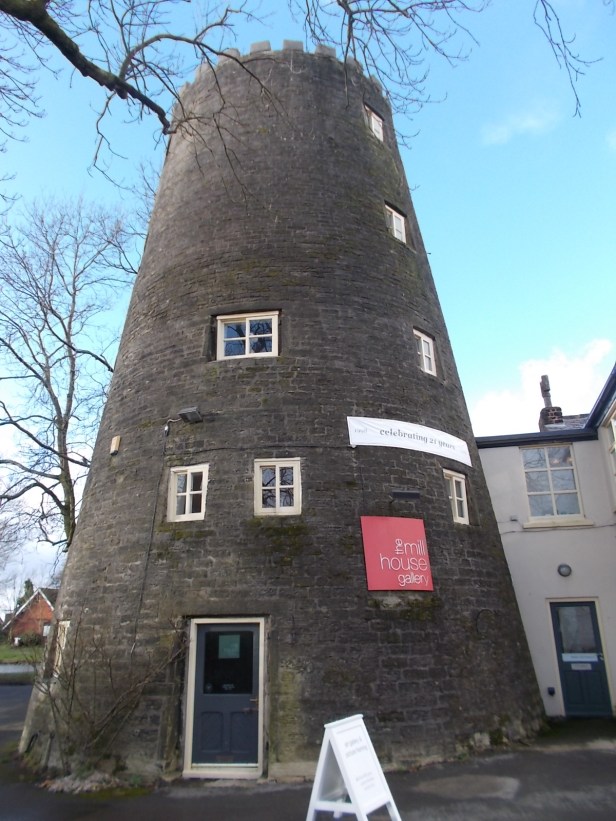Parbold Windmill was built in 1794 as a replacement for the nearby water mill that stood beside the River Douglas. The windmill was constructed next to the Leeds & Liverpool Canal, just 20 years after it opened. This waterway would prove a real boon to the business of milling flour.

The windmill is built from local sandstone, stands five storeys tall and, unusually, has an embattled parapet on top. It now houses the Mill House Gallery, more of which later.
In July 1817, the windmill was put up for auction. It was to be sold complete with a warehouse, a plot of land and all of its machinery. This included two pairs of French stones (from the Marne valley in North France, used for finer grinding), two pairs of grey stones (from the Derbyshire Peak District) and three sets of beams and weights. At the time Nathan Tunstall was the owner and it was known locally as ‘Nathan’s Mill’. The buyer was Richard Ainscough, who had moved to the village just three years before and had set up as a grocer.
When he retired, he passed the windmill on to his son, Richard junior. Richard’s older brother Hugh later joined the business. Hugh had spent four years training to be a Catholic priest in Valladolid in Spain. However he did not become ordained and subsequently considered being a doctor, working with a Dr Hawlett of Wigan. If Hugh had vacillated somewhat over his choice of career in his early life, he more than made up for it by launching a huge range of successful ventures once he was partnered with his brother.

They formed the H & R Ainscough Company, and diversified into farming, land ownership and set up the Burscough horse stud. Hugh was part of the consortium that built the massive Palace Hotel in Birkdale. He was also a director of the Bank of Southport and a Liberal member of Lancashire County Council.
Their milling business was the real powerhouse of the partnership though. They were able to import grain from America, which was brought from Liverpool up the canal to Parbold. Their windmill could not possibly meet the demand so they built two steam powered corn milling factories. One stood on the opposite side of the canal to the windmill and the other one was in the nearby town of Burscough. With the building of these Victorian factories, the windmill became redundant and stopped being used for milling in the 1850s.
Despite suffering a fire in 1951, the Parbold factory lasted until 1985 producing cattle food in its later days. The Burscough factory only closed in the 1990s. It was derelict for a time but has now been saved and converted into apartments.

For much of the next 150 years it’s not clear what the windmill was used for. Such an unusual space can be utilised for a variety of purposes, as was the case at Cragg’s Row Windmill in Preston. It presumably remained in good condition, and was painted by the artist Karl Wood in 1949 (see his picture of it here.) He painted over 1394 windmills across Britain, frequently travelling on his bicycle to reach them. Twenty-one of his Lancashire black and white sketches can be seen on the Mills Archive website. They are a fascinating record of our lost windmills. (See the page here.)
In recent years, Greenalls brewery owned both the lease on the windmill and the Windmill public house next door. In the 1990s, the building was being used as a second hand dress shop. In the 2000s, the fabrics agency Curtain Call moved in. People would sell their curtains through the shop, with the owner retaining a 40% commission. At its height it stocked 200 pairs of curtains, including a pair of French brocades that were 120 years old. When the business closed, the windmill was once again in need of a use.

In 1997, the artist James Bartholomew opened his studio and gallery in the next door Mill House. Starting with just two small rooms, he expanded the business to its present size where there are now seven large rooms of his work on display throughout both the windmill and the adjoining Mill House. Predominantly a landscape and seascape painter, he uses the premises to showcase his newest paintings, and to sell limited editions of his prints. James has created a very welcoming and relaxed setting and visitors are encouraged to browse at their leisure. It is an excellent use of this historic building, allowing the public to enter into the fantastically preserved windmill. See the website here.
The Windmill pub next door must have been a popular place with farmers bringing their corn to be ground in the early days of Parbold Windmill. Just across the road is the café Yours is the Earth. This building was formerly a canal-side warehouse, possibly the one mentioned above in the 1817 auction. On the left hand side of the picture below, note the three loading bays. On the ground floor there is a dark door/window which is was one of them. Above that are two large first and second floor windows which were the other two loading bays. The small square opening above the top window originally held a lifting beam.

For those interested in windmills, there is a ruined one nearby at Harrock Hill. To see a picture of it and its precise location click here.
Access
The Mill House gallery is open Tuesday to Saturday 9.30 am – 5.30 pm.
The website is here
There is parking on site.
The Windmill pub is next door and just across the road is the café Yours is the Earth
Nearby just a short drive away
References
A History of Parbold, J.M. Virgoe (1994) Carnegie Publishing
historicengland.org.uk/listing/the-list/list-entry/1361804
en.wikipedia.org/wiki/Millstone
parboldonline.info/about/village-history.html
ourladysparbold.org.uk/about/the-history/the-ainscoughs-and-the-nelsons/
landedfamilies.blogspot.com/2013/08/61-ainscough-of-parbold.html
en.wikipedia.org/wiki/Birkdale_Palace_Hotel
webcache.googleusercontent.com/search?q=cache:k-_BgSife1AJ:https://www.lep.co.uk/business/the-big-interview-marie-kendall-1-97566+&cd=8&hl=en&ct=clnk&gl=uk
images-of-burscough.co.uk/index.php/surrounding-areas/newburgh/
lincstothepast.com/CASTELLATED-TOWER–PARBOLD–LANCASHIRE/468158.record?pt=S
catalogue.millsarchive.org/drawings-of-windmills-in-lancashire
catalogue.millsarchive.org/informationobject/browse?page=1&ancestor=46661&topLod=0&view=card&onlyMedia=1&sort=lastUpdated&sortDir=desc
jamesbartholomew.co.uk/
geograph.org.uk/photo/3798589
Comments are closed.